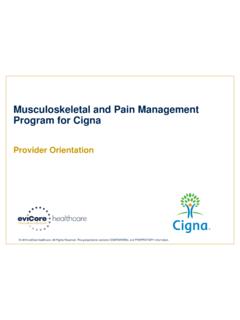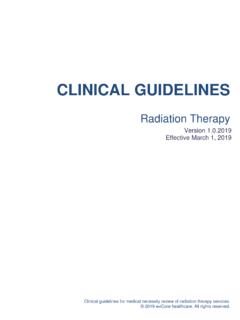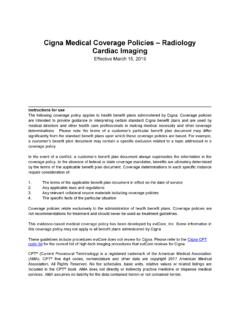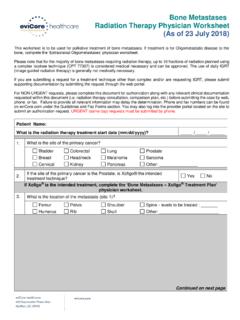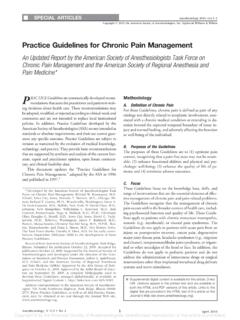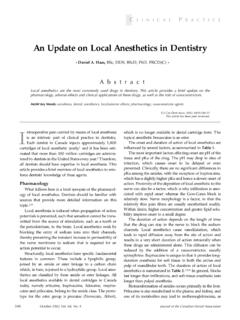Transcription of CODING GUIDELINES - eviCore
1 Radiation Therapy Effective January 1, 2018 CODING GUIDELINES for medical necessity review of radiation therapy services. 2018 eviCore healthcare. All rights reserved. CODING GUIDELINES Page 2 of 12 Please note the following: CPT Copyright 2017 American Medical Association. All rights reserved. CPT is a registered trademark of the American Medical Association. Page 3 of 12 Please note the following: All information provided by the NCCN is Referenced with permission from the NCCN Clinical Practice GUIDELINES in Oncology (NCCN GuidelinesTM) 2018 National Comprehensive Cancer Network. The NCCN GuidelinesTM and illustrations herein may not be reproduced in any form for any purpose without the express written permission of the NCCN. To view the most recent and complete version of the NCCN GUIDELINES , go online to CCI or NCCI (National Correct CODING Initiative) is an initiative taken by CMS.
2 Per the CMS website, The CMS developed the National Correct CODING Initiative (NCCI) to promote national correct CODING methodologies and to control improper CODING leading to inappropriate payment in Part B claims. The CMS developed its CODING policies based on CODING conventions defined in the American Medical Association's CPT Manual, national and local policies and edits, CODING GUIDELINES developed by national societies, analysis of standard medical and surgical practices, and a review of current CODING practices. The purpose of the NCCI Procedure-to-Procedure (PTP) edits is to prevent improper payment when incorrect code combinations are reported. The purpose of the NCCI MUE program is to prevent improper payments when services are reported with incorrect units of service. The CCI and MUE edits are readily available on the CMS website so that providers and hospitals can stay informed and continually update their billing and CODING practices to avoid any unnecessary denials.
3 eviCore adheres to the CMS CCI and MUE edits to control improper CODING leading to inappropriate payment of claims. Since these edits are easily accessible on the CMS website, they are not covered in the eviCore CODING GUIDELINES . Page 4 of 12 eviCore Radiation Therapy CODING GUIDELINES These GUIDELINES summarize definitions and appropriate use of several CPT codes. These GUIDELINES are not meant to be all-inclusive, but are meant to be used in conjunction with the other CODING resources and AMA Current Procedural Terminology (CPT) code book. The last section of the GUIDELINES lists standard groups of codes that may be reimbursed for specific clinical cases. The presence of a code in a group does not guarantee approval of a claim for that code. Approval is based on clinically appropriate use of the code. I. Individual Code Definitions CPT codes 77370 and 77470 are used to report the additional time and effort required when a medical physicist and radiation oncologist must plan for and deliver treatment under unusual clinical circumstances.
4 Neither code should be billed routinely in connection with usual and customary services. Exceptions or additions to this guide will be made on a case-by-case basis with appropriate documentation. A. 77470 The radiation oncologist bills 77470 when the complexity of the radiation therapy treatment plan is such that additional time and effort are required to deliver treatment effectively. Patient-specific documentation is required to substantiate the medical necessity of this code. 77470 may be medically necessary in treatment plans for which one or more of the following techniques are ,2,3,4 1. Concurrent chemotherapy (not 30 days before or 30 days after, but concurrent with the radiation treatments Herceptin , Temodar , and hormonal therapy do not typically add additional work effort and are therefore not considered sufficient to qualify for reimbursement under this code) 2.
5 Brachytherapy 3. Total body irradiation (TBI) 4. Hemi-body radiation 5. Per oral 6. Endocavitary irradiation 7. pediatric patient requiring daily anesthesia and daily physician supervision 8. Hyperthermia 9. Cases requiring reconstruction of previous treatment plans; or combined dose effects of brachytherapy and external beam treatment 10. Selective Internal Radiation Therapy (SIRT) 11. Radioimmunotherapy when combined with external beam treatment 12. Twice a day treatment (BID) Page 5 of 12 Procedures for which 77470 should not be billed include the following: 1. Contouring for three-dimensional conformal radiation therapy (3D-CRT) 2. Contouring for intensity modulated radiation therapy (IMRT), even when multiple image sets are referenced 3. Reviewing a multi-phase plan when the physicist has done the work of summing the plans. 4. The work required for the 4 DCT performed during simulation for treatment utilizing respiratory gating Routine use of 77470 for standard breast cancer planning or standard prostate IMRT planning is not reimbursable.
6 Routine use of 77470 for SRS/SBRT is not reimbursable CPT code 77470 is reported once per course of B. 77370 CPT code 77370 is very similar to 77470 in that it documents additional work that is not routinely required for a radiation therapy episode of care. Billing for this code is also limited to unusual clinical situations, and is only appropriate for work performed by a board certified medical physicist. 77370 should not be applied to situations in which the physicist is performing quality assurance services. This code includes a technical component 77370 may be medically necessary for treatment plans in which one or more of the following techniques or factors are ,5,6 1. Complex interrelationships of electron and photon ports. This code will not be reimbursed for an EBRT boost for breast cancer 2. Brachytherapy 3. Analysis of special devices and blocking to protect critical organs for treatment delivery that is not routinely required 4.
7 Analysis of treatment areas that are abutting or overlapping with a previously treated area 5. Analysis of potential complications that a pregnant patient may experience as a result of treatment delivery 6. Fusion of three-dimensional image sets from multiple modalities, , computerized tomography (CT), positron emission tomography (PET) and magnetic resonance imaging (MRI) (77370 should not separately be reported with IMRT planning code 77301, even when image fusion is done. The work effort for 77301 includes fusion of image sets) 7. Patient with a pacemaker/defibrillator/prosthesis within close proximity to treatment fields 8. Patient-specific treatment circumstances that require corrective measures to solve a discrepancy, correct a treatment error and ensure proper completion of treatment Page 6 of 12 9. Fusion and blending of multiple treatment plans including previously completed treatments for a specific patient circumstance 10.
8 Radioimmunotherapy (for patients previously treated with external beam and an evaluation of a critical organ dose is required) 11. SIRT Procedures for which 77370 should not be billed include the following: 1. Verification of dose distribution and monitor units/dose accuracy for 3D/IMRT plans Electron cutout measurements/dose measurements 2. In-vivo dosimetry 3. The work required for the 4 DCT performed during simulation for treatment utilizing respiratory gating CPT code 77370 is not routinely reported for SRS/SBRT. CPT code 77370 is reported once per course of therapy. Use of this code requires a physician s request detailing what analysis should be performed, together with a custom report from the physicist specifically addressing items in the physician s request. Check-off sheets and repetitive templates are insufficient to serve as documentation of a customized special physics request. Exceptions to this policy will be made on a case-by-case basis with appropriate supporting documentation.
9 Evidence to substantiate an exception should be submitted when authorization is requested. C. 77300 CPT code 77300, basic radiation dosimetry calculation, is billed for a mathematical computation of the radiation dose at a particular point, a calculation related to source decay, or another independent calculation. Calculations are required for both external beam radiation therapy and brachytherapy and must be prescribed by the treating physician. Calculations are typically charged at a rate of one unit of CPT code 77300 for each unique verification calculation (generally one per port, arc, path or gantry angle). If treating breasts using multiple segments within each field (field in field), eviCore will approve up to 4 segments (4 units of 77300) per gantry angle for each unique field (see #11). The use of multiple segments for other treatment areas would be considered on a case-by-case basis.
10 There must be a second algorithmic calculation that is separate and distinct from the isodose plan. The organs of interest or regions of interest are not reported as basic calculations but are considered to be included in the isodose As of January 1, 2015, new CPT codes 77306, 77307, 77316, 77317 and 77318 along with 77321 include the work associated with the basic dosimetry calculation(s). As of January 1, 2016, new CPT codes 77767, 77768, 77770, 77771, 77772, 0394T Page 7 of 12 and 0395T as well as code 77295 include the work associated with the basic dosimetry calculation(s). The edit involving 77295 and 77300 was deleted in the July 1, 2016 version of the National Correct CODING Initiative (NCCI). The deletion is retroactive to January 1, 2016, the implementation date of the edit. Code 77300 should still not be reported with the other listed ,8 77300 may be medically necessary for the ,10,11 1. Central axis depth dose 2.
